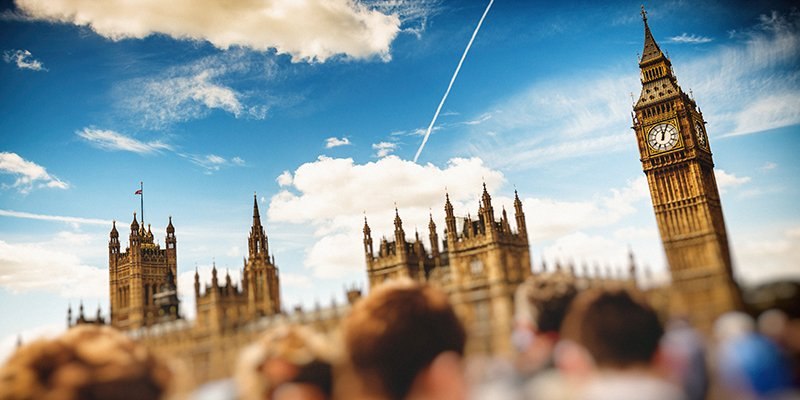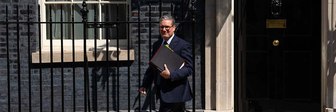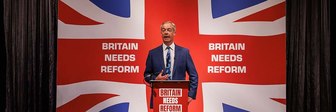Tory seat total would also be a record low
Our final MRP model ahead of the general election on Thursday shows a large Labour majority and a crushing defeat for the Conservative party.
Our central projections are vote shares of 22% for the Conservatives, 39% for Labour, 15% for Reform UK, 12% for the Liberal Democrats and 7% for the Greens.
These would result in 431 seats for Labour, 102 for the Conservatives, 72 for the Liberal Democrats, 2 for the Greens and 3 for Reform UK. The SNP have 18 seats in Scotland, and Plaid Cymru 3 in Wales.
Compared to our MRP model at the start of the election campaign the Conservatives have dropped three points and Labour have dropped four points, with the Liberal Democrats up one and Reform UK up five. The impact however has largely been to increase Labour and particularly the Liberal Democrats' seat numbers, suggesting much of that movement is anti-Conservative voters making tactical decisions on how best to remove them.
An MRP model, like any polling exercise, has a margin of error. We expect the Conservative shares of the vote to be between 19% and 25%, Labour to be between 34% and 43%, the Liberal Democrats between 9% and 16% and Reform between 11% and 20%.
This is especially the case at the seat level. Our prediction has 89 seats where the top two parties are within 5% percent of each other. That means a small movement in the overall share of the vote could equate to a large number of seats changing hands. This is particularly the case in Scotland, where the distribution of the SNP vote is relatively flat, and there are large number of seats that could easily change hands on just a small shift in the vote.
What does this mean in practice? Our range for the number of Conservative seats is between 78 and 129 seats, while our range for the Liberal Democrats is between 57 and 87. That means at one end of the realistic possibilities is that we wake up on Friday to find Ed Davey is Leader of the Opposition. At the other end of possibilities is that the Tories are in a secure second place. The most likely outcome is the Conservatives just over 100 seats, the Liberal Democrats on around 72.
What we can be absolutely confident upon is the winner. Labour are set to win, and set to win big. Even at the lowest end of our prediction Labour would have 391 seats and a majority of 132. At the top end of our prediction they would have 466 seats - a crushing majority of 282. Our range of possibilities goes from a large Labour majority to an exceptionally large Labour majority.
And, it is worth saying, election day itself is still to come. Many votes have been cast by post, but the majority will be cast on the day. Some people will make their minds up at the last minute, the efforts of party volunteers leafleting and knocking up on the day do make a difference. In a projection when many seats are balanced on a knife edge, that itself could make a difference in many individual races.
Swing and proportionality
This election will be like none we have seen before, with Labour set to reverse their worst result since 1935 to potentially a record-breaking victory in just one electoral cycle. The scale and speed of this change provides unique challenges for modelling how shifts in vote intention will fall out at the constituency level – even for MRPs.
We have already seen how a wide range of potential post-election scenarios are contained within the plausible seat intervals projected for each party. Much of what determines how the drop in Conservative support in particular will shape seat counts post-election is to do with the proportionality of the swing against them. YouGov estimate that the Conservatives will drop most where they start out strongest (in terms of 2019 results), thus making the swing from 2019 to 2024 ‘proportional’.
While there is a general expectation across pollsters and analysts that swing will indeed be proportional this time around – that being different to the vast majority of British elections, in which it tends to be uniform – the extent of that proportionality can be the difference between a scenario in which the Conservatives on around 22% of the vote could drop as low as 60 seats or reach as high as 140 seats.
The Conservative vote share at the 2019 general election was roughly 44%. We estimate that the Conservatives will win 22% of the vote share tomorrow. This would be a literal halving of the party’s support since the last election.
We estimate that the proportionality of the swing will be approaching 1:1 proportionality, but will stop short of a situation where, for example, the Conservatives are on 50% on the vote in 2019 and end up on 25% tomorrow. We would anticipate that value to be around 26% or 27%.
If the swing is more proportional than we estimate, then the Conservatives will end up with fewer seats. If the swing is less proportional than we estimate, then the Conservatives will lose less. With no historical markers or comparators for us to benchmark this coming election against, it is very difficult to tell exactly which way this relationship will fall. This, plus the usual caveats around polling regarding statistical uncertainty and margins of error, serve as a reminder to set expectations wide as to exactly what sort of election result we may see come July 5th.
As well, 89 seats are being declared ‘tossups’ in this final call, with the projected winner 5 percentage points or less ahead of their nearest rival. The tossup call means that, realistically, we expect that they could easily go either way (or even one of three ways) on Thursday. This adds another layer of uncertainty as to the actual result.
Which seats are on a knife-edge?
Our latest model has 89 seats as toss ups – meaning that the winning party's lead is less than five points. A total of 28 of these seats have the winner and second place within 1% or less of each other.
The Conservatives are in tossups in 42 of their total 102 seats and for Labour 40 of their 431 seats are tossups.
63 marginal seats are contests between the Conservatives and Labour. Currently, they are evenly split on who is set to win them, with Conservatives taking 33, Labour 30 – but these seats are on a knife-edge and could ultimately fall to either one of these parties.
Elsewhere, the Lib Dems are neck-and-neck with the Conservatives in seven seats (which Conservatives currently lead in five of). The Lib Dems are also in a tight fight with the SNP in Caithness, Sutherland and Easter Ross, where they are currently set to win. Reform UK are in a battle with Labour in three constituencies (Folkestone and Hythe, Basildon and Billericay, and Ashfield), being narrowly ahead in the latter. They are also a close second to the Conservatives in Boston and Skegness.
There are also four three-way marginal seats. The Conservatives are in the lead in two of these, competing closely with Labour and Reform UK (Bromsgrove) or Labour and the Liberal Democrats (Exmouth and Exeter East). SNP lead in another, Mid Dunbartonshire, competing with Labour and Liberal Democrats. Labour lead in the final one, Ynys Môn, competing with Plaid and the Conservatives.
Importantly, the margin of error varies from seat to seat. We provide upper and lower figures along with error bars on the interactive MRP map on our election hub.
The average error of a seat will increase when there are specific local factors at play that are difficult to fully account for in our model.
Reform UK set to win seats for the first time
Our final model has Reform UK winning three seats, with Nigel Farage set to become the MP for Clacton. The party leader is on 40% of the vote here, ten points ahead of the Conservatives on 30%. Another East of England seat, Great Yarmouth, is also leaning to Reform UK, while Ashfield, where Tory defector Lee Anderson is hoping to retain his seat, is just ahead in a neck and neck contest with Labour.
There are three further seats where Reform UK are in second place, but it is incredibly close between them and the leading party. This includes Boston and Skegness, where party chairman and former leader Richard Tice will be hoping to get over the line in a tossup with the Conservatives.
Basildon and Billericay, and Folkestone and Hythe are very close races between Labour and Reform UK, with both seats having been Conservative in 2019.
There are 107 seats in total where Reform UK are in second place, though the vast majority of these (97) are either safe or likely Labour seats.
Lib Dems on track to tear down the Blue Wall
Our final model has the Liberal Democrats winning a record high 72 seats - more than six times their 2019 tally and surpassing their 2005 record of 62 seats.
Based on 2019 nominal results, Ed Davey’s party are set to take 62 seats from the Conservatives while two are gains from the SNP.
Our model suggests that the party will perform best in the South, taking 23 seats in the South West and 25 seats in the South East.
Outside of the South the party is set to win 18 seats. Some of the closest races are in Scotland – one to watch is Edinburgh West.
There are similar scenes in London, where we expect the Lib Dems to collect a total of six seats in the capital. This includes Wimbledon – a seat dating back to 1885 where the Liberal Democrats have never won before.
On top of the 72 seats they’re expected to win, our model suggests that the Liberal Democrats are a close second in five further constituencies, in each case challenging the Tories.
Greens set to add an historic second seat
The Green Party is projected to win two seats in tomorrow’s election: Brighton Pavilion and Bristol Central. Brighton Pavilion was the only seat won by the Greens in the 2019 election, and the party’s vote share has remained largely unchanged at 55%. In Bristol Central, the Greens are projected to win 52% of the vote. In both constituencies, Labour trails in a distant second place with a projected 27% and 34% vote share, respectively.
The Green Party is the runner-up in an additional 36 constituencies, mostly trailing Labour, except for North Herefordshire and Waveney Valley, where they are second to the Conservative Party.
On average, the Greens are around 40 points behind in those constituencies where they are second to Labour. In those two areas where they come second to the Conservatives, it is somewhat a closer call: in North Herefordshire, Sunak’s party is ahead by 10 points while in Waveney Valley the Tory lead stands at eight points.
Almost half of the constituencies where the Greens are the runner-up are located in London (16), with seven in the North West and three in Yorkshire and the Humber.
Labour set to become largest party in Scotland
According to our latest MRP Labour will become the largest party in Scotland by a margin of 14 seats. Our seat totals have Labour taking 32 (a change from 28 since our last MRP two weeks ago) seats, the SNP 18, the Conservatives three (of which all are tossups) and the Lib Dems four.
The two constituencies that were held by Alba MPs (Lothian East, and Cowdenbeath and Kirkcaldy) are estimated to be taken by Labour.
Even for an election with such a dramatic change in the composition of the House of Commons, the churn in Scotland is notable. Thirty six seats are changing hands according to our model, almost two thirds of the total number of seats (57).
Scotland is also notably more marginal than England. Thirteen of the 57 seats are tossups – meaning that the winning party's lead is less than five points. In all these, the SNP are one of the two parties vying for the top spot, with Labour competing in six, the Conservatives three and the Lib Dems in one.
With so many seats in Scotland being marginal, there is a relatively wide range of potential outcomes in the country. The upper end of our estimates see Labour taking 38 seats, and at the lower end just 19. Meanwhile, the most optimistic scenario for the SNP sees them winning 32 seats but eight in the most pessimistic scenario.
Conservatives to lose all seats in Wales
The Conservatives could be completely wiped out in Wales with our final MRP model showing they are on track to lose all seats they held at the last election. Our previous model showed them retaining Montgomeryshire and Glyndwr, but following the suspension of Craig Williams amid the election betting scandal, this seat has become a tossup with Labour marginally ahead.
Despite Labour achieving an overall vote share in Wales similar to 2019, which left them with their fewest seats in 40 years, our model shows them on track to win 28 out of 32 seats in the country, with Plaid Cymru winning three and the Liberal Democrats one.
This includes Labour regaining control in the north east of Wales in seats like Wrexham that switched to the Conservatives in 2019. Our model also shows them ahead in all seats in the south of the country, though Llanelli is a tossup with Plaid Cymru.
Plaid Cymru are likely to hold on to Ceredigion Preseli and Dwyfor Meirionnydd, and are in three way battles with Labour and the Conservatives for Caerfyrddin and Ynys Mon. The Liberal Democrats are set to win the seat of Brecon, Radnor and Cwm Tawe from the Conservatives, their first Westminster seat won at a general election in Wales since 2015.
Labour on for record showing in London
As with our two previous MRP projections, it appears the Conservatives are heading for a formidable defeat in the capital. Our model shows the Tories ahead in only six of the 75 seats available in London, and in five of these the results are a tossup, with Labour breathing down their necks.
Keir Starmer’s Labour Party are set to win 63 seats, which will result in an unprecedented 84% of London seats, (the party won 77% of seats in 1997). This dominant result alongside the re-election of Sadiq Khan as Mayor of London back in May, paints the picture of the capital becoming a one-party city.
Our final model also suggests that more yellow seats will appear in London, with the Liberal Democrats ahead in six seats, which would be double their 2019 tally.
Many prominent Conservatives look likely to lose their seats in the coming contest
Currently the Tory ministers looking set to lose to the Liberal Democrats are:
- Jeremy Hunt, Chancellor (Godalming and Ash)
- Alex Chalk, Justice Secretary (Cheltenham)
- Michelle Donelan, Science Secretary (Melksham and Devizes)
- Gillian Keegan, Education Secretary (Chichester)
- Michael Tomlinson, Minister of State for Countering Illegal Migration Secretary (Mid Dorset and North Poole)
- Lucy Frazer, Culture Secretary (Ely and East Cambridgeshire)
The Lib Dems also look likely to take Theresa May’s vacated seat of Maidenhead, David Cameron’s former Witney constituency, Dominic Raab’s former seat of Esher and Walton and Michael Gove’s former seat of Surrey Heath.
Senior Conservatives who are likely to lose their seats to Labour include:
- Grant Shapps, Defence Secretary (Welwyn Hatfield)
- Mark Harper, Transport Secretary (Forest of Dean)
- David T C Davies, Wales Secretary (Monmouthshire)
- Steve Baker, Northern Ireland Minister (Wycombe)
- Johnny Mercer, Minister of State for Veterans' Affairs (Plymouth Moor View)
- Penny Mordaunt, Leader of the House (Portsmouth North)
- Greg Hands, Minister for London and Minister of State for Trade Policy (Chelsea & Fulham)
- Esther McVey, Minister of State without Portfolio (Tatton)
Our results also show a tight contest in Work and Pensions Secretary Mel Stride's seat of Central Devon, with Labour slightly out in front of the Conservatives, whilst the Basildon and Billericay constituency being contested by Tory chairman Richard Holden's is currently a close Labour-Reform battle.
The impact of Labour is further evident by claiming seats of former prominent Tory figures such as:
- Boris Johnson, former Prime Minister (Uxbridge and South Ruislip)
- Iain Duncan Smith, former Tory leader (Chingford and Woodford Green)
- Jacob Rees-Mogg, former Leader of the House of Commons (North East Somerset and Hanham)
There is a close call between the two main parties with Conservatives currently edging a win in former Prime Minister Liz Truss’s seat of South West Norfolk.
Separately, chief whip Simon Hart’s seat of Caerfyrddin is currently leaning towards Plaid Cymru.
Independent candidates
As in the previous iteration of our model, Jeremy Corbyn remains the strongest performing independent candidate. Our model has Labour only narrowly ahead in Islington North, and we'd regard the seat as a tossup. Faiza Shaheen, who was deselected as Labour's candidate, is also polling strongly in Chingford and Woodford Green, but our model still places her third behind Labour and the Conservatives.
Elsewhere there is substantial support for other and independent candidates in some of Labour's safer seats, particularly in areas where there are many Muslim voters and independent candidates focusing on the issue of Gaza. Notable examples include Leicester South, Oldham West, Bradford West, Blackburn and both Ilford seats. In all of these cases, Labour still looks set to hold onto the constituencies with ease.
Of the two former Tory MPs running as independents neither Julian Knight in Solihull West and Shirley nor Andrew Bridgen in North West Leicestershire appear to have any significant support.
Following the betting scandal, there are also some candidates who have been disowned by their party but will still appear on the ballot paper as their party's candidate. In Montgomeryshire and Glyndwr the outgoing Conservative MP Craig Williams is narrowly behind Labour. In Central Suffolk and North Ipswich the Labour candidate Kevin Craig has been suspended from the party after betting on himself to lose the election. Our model currently has the seat as a tossup, with Labour narrowly ahead, raising the possibility that Mr Craig may still win the election (but lose his bet).
Tories fall to third place in the South West, with Labour becoming the largest party
According to our model, Labour is now the largest party in the South West and are ahead in 24 seats of the 58 that are up for grabs in the region - though the Lib Dems are closely challenging this lead on 23 seats. The Conservatives have now been pushed from first to third place here, taking only 10 seats. Four of the ten constituencies the Conservatives are set to win are tossups and could be further wins for Labour.
Much the same as our previous two MRPs, Labour likewise looks set to become the largest party in the South East with 38 out of 91 possible seats. Even during their 1997 landslide, Labour had still trailed the Tories in the South East on 22 seats to 54. The Conservatives are predicted to keep just 27 seats and risk falling behind the Lib Dems, who are on 25.
Across the South of England as a whole, excluding London, Labour are set to take 93 seats. In a region of the UK they have historically dominated, the Conservatives are taking just 58. The Lib Dems are neck and neck with the Tories for second place on 55 seats in total with Reform UK and the Greens take a further 2 seats each. In 1997, Labour took just 59 seats in the South to the Conservatives’ 109.
With London included, Labour’s total seats across the South rises to 156, more than double that of the Conservatives on just 64. Again, the race for second largest party is incredibly close, as the Lib Dems take 61 seats, trailing the Tories by just 3. In comparison, 1997 was a much better showing for the Conservatives, taking 120 seats to Labour’s 116.
While the Blue Wall crumbles in the South, the Red Wall is being rebuilt in the North
Our model forecasts that the Conservatives are nearing a total wipeout in the North of England. In both the North East and North West, the party is heading towards zero seats. Across the North altogether, the Red Wall is set to be a sturdy 143 seats with the Conservatives expected to keep just 6 in Yorkshire and the Humber - including Rishi Sunak’s Richmond and Northallerton constituency. Labour looks to dominate in the North West, winning 69 of a possible 72 seats, with the Lib Dems taking the remaining 3. Meanwhile, the North East is facing a complete red takeover with all 27 seats going to Labour.
What do you think about a Labour landslide, the election campaign, and everything else? Have your say, join the YouGov panel, and get paid to share your thoughts. Sign up here.
Photo: Getty


















